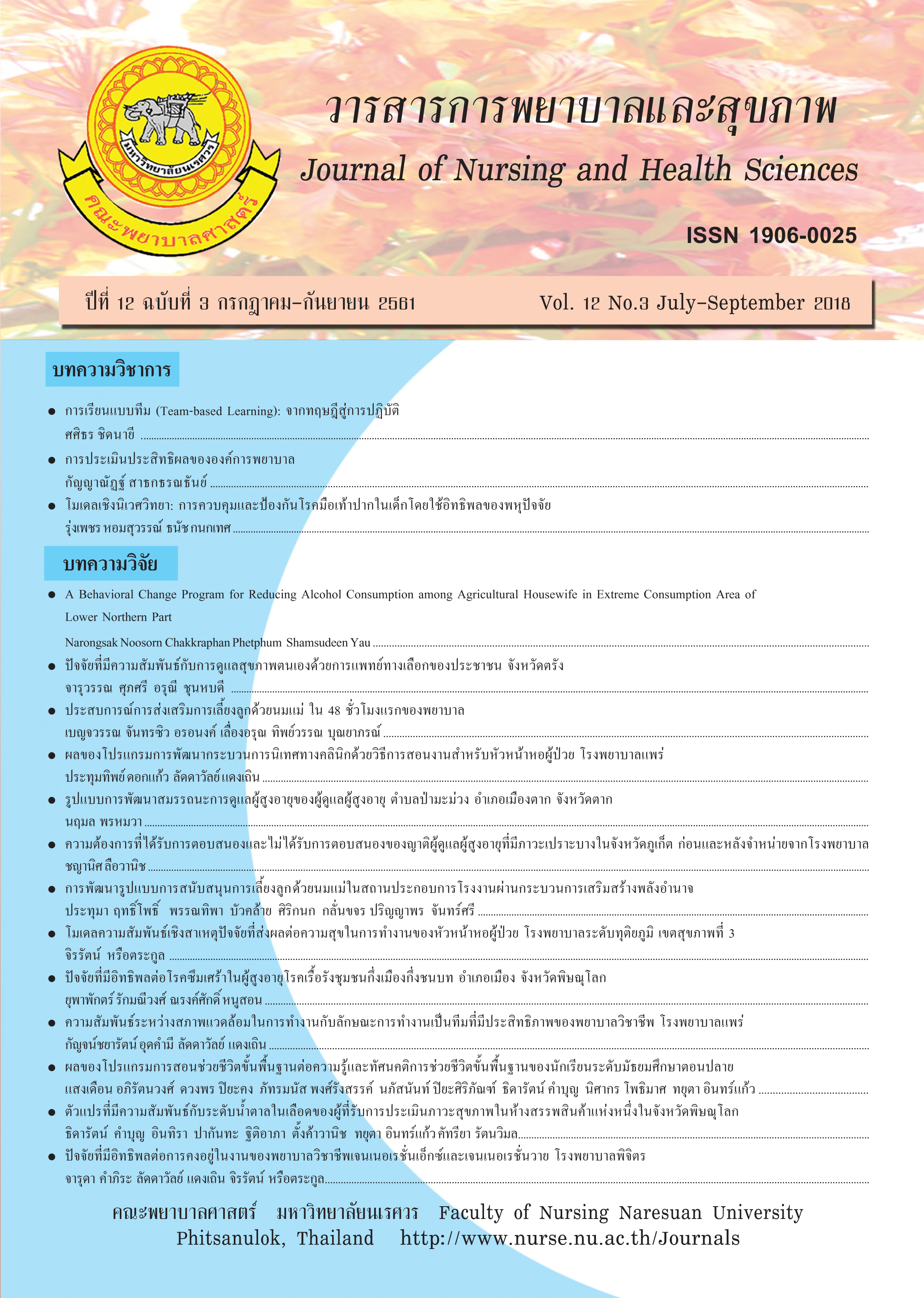ปัจจัยที่มีอิทธิพลต่อการคงอยู่ในงานของพยาบาลวิชาชีพเจนเนอเรชั่นเอ็กซ์และเจนเนอเรชั่นวาย โรงพยาบาลพิจิตร
Main Article Content
บทคัดย่อ
การวิจัยเชิงพรรณนา (Descriptive research) ในครั้งนี้ มีวัตถุประสงค์เพื่อศึกษา 1) ปัจจัยด้านบุคคล ปัจจัยด้านองค์การ ตามการรับรู้ของพยาบาลวิชาชีพเจนเนอเรชั่นเอ็กซ์และเจนเนอเรชั่นวาย 2) การคงอยู่ ในงานของพยาบาลวิชาชีพเจนเนอเรชั่นเอ็กซ์และเจนเนอเรชั่นวาย และ 3) ปัจจัยด้านบุคคลและปัจจัย ดา้ นองค์การที่มีอิทธิพลตอ่ การคงอยูใ่ นงานของพยาบาลวิชาชีพ กลุม่ ตัวอย่างเป็น พยาบาลวิชาชีพเจนเนอ เรชั่นเอ็กซ์และเจนเนอเรชั่นวาย ที่ปฏิบัติงานในกลุ่มการพยาบาล โรงพยาบาลพิจิตร จำนวน172 คน เครื่องมือที่ใช้ในงานวิจัยในครั้งนี้ คือแบบสอบถาม ประกอบด้วยคำถาม 3 ส่วน ได้แก่ ข้อมูลทั่วไปที่เปน็ ปัจจัยด้านบุคคลปัจจัยด้านองค์การและการคงอยู่ในงานของพยาบาลวิชาชีพซึ่งผ่านการตรวจสอบความตรง โดยผู้ทรงคุณวุฒิ 5 คนและความเที่ยงของแบบสอบถาม โดยคำนวณหาค่าสัมประสิทธิ์แอลฟาของครอนบาคได้ ค่าความเที่ยง ส่วนที่ 2 และ 3 เท่ากับ 0.97 , 0.87 ตามลำดับ วิเคราะห์ข้อมูลโดยใช้โปรแกรมสำเร็จรูป หา ค่า ร้อยละ ค่าเฉลี่ย ส่วนเบี่ยงเบนมาตรฐานการวิเคราะห์การถดถอยพหุคูณเชิงเส้นตรงด้วยวิธีการคัดเลือกตัว แปรแบบขั้นตอน (Multiple Linear Regression Analysis with Stepwise Selection Method) ผลการศึกษา 1) ปัจจัยด้านบุคคล พบว่า พยาบาลวิชาชีพเจนเนอเรชั่นเอ็กซ์และเจนเนอเรชั่นวาย มีอายุ เฉลี่ย 37.87 ปี (SD = 9.43) เป็นเจนเนอเรชั่นเอ็กซ์ ร้อยละ59.30 และเจนเนอเรชั่นวาย ร้อยละ 40.70 และ ปัจจัยด้านองค์การโดยรวมอยู่ในระดับปานกลาง 2) การคงอยู่ในงานของพยาบาลวิชาชีพเจนเนอเรชั่นเอ็กซ์ และเจนเนอเรชั่นวายโดยรวมอยู่ในระดับมาก และ 3)ปัจจัยองค์การด้านคุณลักษณะขององค์การเกี่ยวกับ ความมั่นคงในงาน ด้านลักษณะงาน และการทำงานเกี่ยวกับความยืดหยุ่นของเวลาทำงาน และปัจจัย ด้านบุคคล คืออายุ มีอิทธิพลต่อการคงอยู่ในงานของพยาบาลวิชาชีพเจนเนอเรชั่นเอ็กซ์และเจนเนอเรชั่น วาย ในโรงพยาบาลพิจิตร อย่างมีนัยสำคัญทางสถิติระดับ 0.01 โดยสามารถร่วมกันทำนายการคงอยู่ในงาน ได้ร้อยละ25.4
Article Details
เอกสารอ้างอิง
ในหน่วยบริการสุขภาพของสำนักงานปลัด
กระทรวงสาธารณสุข: ข้อเสนอเชิงนโยบาย.
วารสารวิชาการสาธารณสุข, 26(2), 456-468.
กฤษณี ก้อนพิงค์.(2552).ความตั้งใจคงอยู่ในงาน
ของพยาบาลห้องผ่าตัดโรงพยาบาลศิริราช.
วิทยานิพนธ์ปริญญา ปริญญาวิทยาศาสตร
มหาบัณฑิต สาขาวิทยาการสังคมและการจัดการ
ระบบสุขภาพ บัณฑิตวิทยาลัย,มหาวิทยาลัย
ศิลปากรม,กรุงเทพฯ.
ดุษฎี เอกพจน์.(2551).ปัจจัยพลต่อการคงอยู่ในงานของ
พยาบาลวิชาชีพ โรงพยาบาลสามจังหวัดชายแดน
ภาคใต้.วิทยานิพนธ์ปริญญาพยาบาลศาสตร
มหาบัณฑิต แขนงวิชาการบริหารการพยาบาล
สาขาวิชาพยาบาลศาสตร์, มหาวิทยาลัย สุโขทัย
ธรรมาธิราช.
นงลักษณ์ พะไกยะและเพ็ญนภา หงส์ทอง. (2554).
กำลังคนด้านสุขภาพ:ที่เป็นมา เป็นอยู่และ
จะเป็นไป. กรุงเทพมหานคร:พริมท์แอทมี.
นิตยา วันทยานันท์.(2556).ปัจจัยที่มีความสัมพันธ์กับ
ความตั้งใจคงอยู่ในงานของพยาบาลวิชาชีพกลุ่ม
ลูกจ้างชั่วคราวโรงพยาบาลในเขตจังหวัดสกลนคร.
วิทยานิพนธ์ปริญญาพยาบาลศาสตรมหาบัณฑิต
สาขาวิชาการบริหารการพยาบาล คณะพยาบาล
ศาสตร์มหาวิทยาลัยบูรพา
บงกชพร ตั้งฉัตรชัย.(2553). ปัจจัยที่มีผลต่อการคงอยู่ใน
งานของพยาบาลวิชาชีพ โรงพยาบาลศูนย์ เขต
ภาคตะวันออกเฉียงเหนือ สังกัดกระทรวง
สาธารณสุข.วิทยานิพนธ์ปริญญาพยาบาลศาสตร
มหาบัณฑิต แขนงวิชาการบริหารการพยาบาล
สาขาวิชาพยาบาลศาสตร์,มหาวิทยาลัยสุโขทัย
ธรรมาธิราช.
บุญใจศรีสถิตย์นรากูร. (2551). ภาวะผู้นำและกลยุทธ์
การจัดการองค์การพยาบาลในศตวรรษที่ 21
(พมิ พค์ รั้งที่ 2).กรุงเทพฯ:โรงพิมพแ์ หง่ จุฬาลงกรณ์
มหาวิทยาลัย.
รัตน์ศิริทาโต. (2551). การวิจัยทางพยาบาลศาสตร์:
แนวคิดสู่การประยุกต์ใช้.กรุงเทพมหานคร :
สำนักพิมพ์แห่งจุฬาลงกรณ์มหาวิทยาลัย.
โรงพยาบาลพิจิตร. (2560).รายงานประจำปี 2560.
พิจิตร: โรงพยาบาลพิจิตร.
โรงพยาบาลพิจิตร.(2560).รายงานการประชุม
คณะกรรมการบริหาร โรงพยาบาลพิจิตร
ประจำเดือน ธันวาคม 2560.พิจิตร: โรงพยาบาล
พิจิตร.
วันเพ็ญ นาสอนใจ, มุกดา หนุ่ยศรีและวาริณี เอี่ยมศิริกุล.
(2558). ปัจจัยที่มีอิทธิพลต่อการคงอยู่ในงาน
ของพยาบาลวิชาชีพโรงพยาบาลชุมชนจังหวัด
เพชรบูรณ์.วารสารพยาบาลทหารบก,17(2),
43-50.
สุรีย์ท้าวคำลือและพนิดาดามาพงศ์. (2550). ปัจจัย
คัดสรรที่ทำนายความตั้งใจที่จะคงอยู่ในงาน
ของพยาบาลวิชาชีพโรงพยาบาลเอกชน
เขตกรุงเทพมหานคร.วิทยานิพนธ์ปริญญา
พยาบาลศาสตร์มหาบัณฑิต สาขาวิชาการ
บริหารการพยาบาล จุฬาลงกรณ์มหาวิทยาลัย.
สำนักนโยบายและยุทธศาสตร์กระทรวงสาธารณสุข.
(2560).แผนยุทธศาสตร์ชาติด้านสาธารณสุข
และเป้าหมายปฏิรูป 18 เดือน.สืบค้นเมื่อ10
สิงหาคม 2560, จากhttps://www.hfocus. org/
content/2016/06/12331
อรุณรัตน์คันธา. (2557). ผลกระทบและทางออกของการ
ขาดแคลนกาลังคนทางการพยาบาลในประเทศ
ไทย.Journal of Nursing Science, 32(1), 81-90.
Cowin ,L.S.(2002). The Self-Concept of Nurses and
its Relationship to Job Satisfaction and
Retention.Dissertation,
Ph. D. (Philosophy). Sydney: Graduate School The
University of Western Sydney at Sydney.
Photocopied.
Lim,G.S., Mathis,R.L. , Jackson ,J.H.(2010). Human
Resource Management: an Asia edition.13th
Edition, South-Western College Publishing,
Ohio.
Tremblay ,L.M., Leclerc ,E.,Marchionni C, &
Drevniok, U.(2010).The needs and expectations
ofgeneration y nurses in the workplace. Journal
for Nurses In Staff Development.26 (1), 2-8.
Mathieu,J.E.,Zajac,D.M.,(1990). A review and
meta-analysis of the antecdents, correlates, and
consequences of organizational commitment.
Psychological Bulletin.108,171-194.
Mayer,J.P., Allen,N.J.(1984).Testing the sidebet
theory of organizational commitment:
Some methodological considerations. Journal
of Applied Psychology.69,372-278.
Mobley, H. H. (1982). Employee turnover case
consequences and control. Texas: Addison
Wesley.
United Nations, Department of Economic and Social
Affairs,Population Division. (2015). World
Population Prospects: The 2015 Revision.
New York: UN.
Zemke, R., Raines, C.,Filipczak, B.(2000). Generations
at work: Managing the Clash of Veterans,
Boomers, Xers, and Nexters in Your Workplace,
Amacon ,New York.


